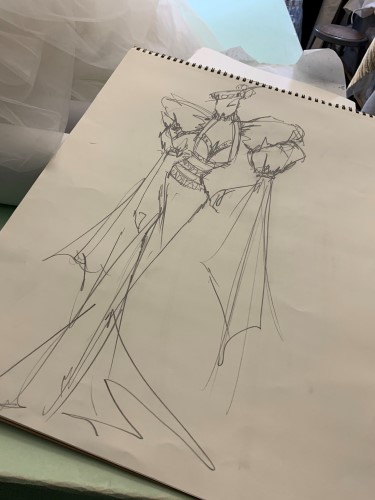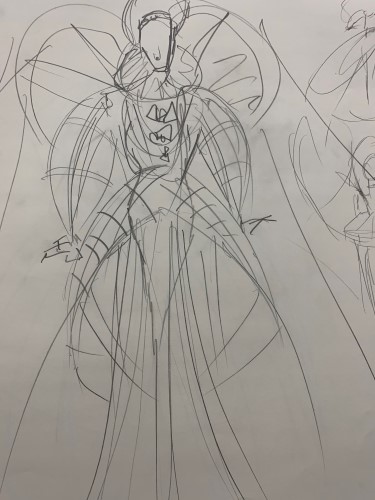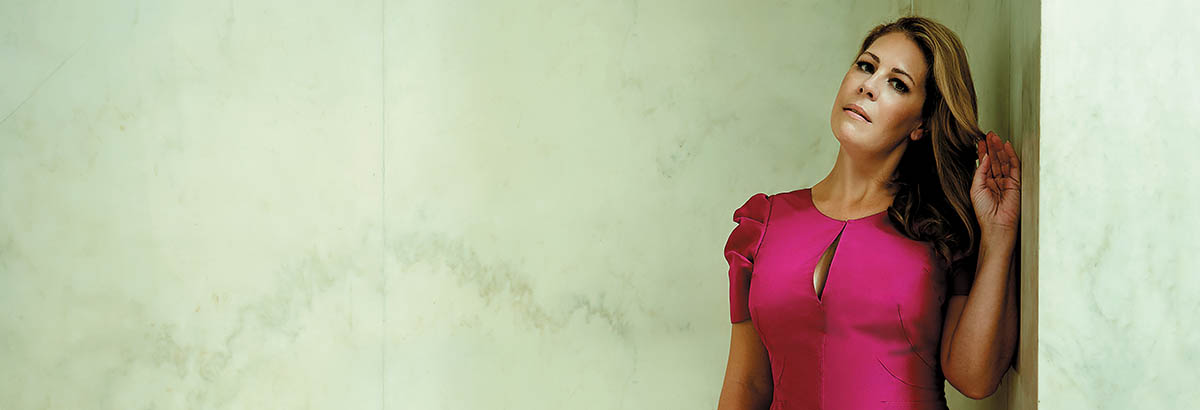November 16, 2019
Dramatic gowns fit for three queens
Sondra Radvanovsky’s theatrically magnificent “Three Queens” gowns, which made their debuts on Sunday, December 1 at Lyric, evoke the operatic and actual queens without being historical artifacts. American designer Rubin Singer has created three extraordinary fashion statements, collaborating with jewelry designer and philanthropist Ann Ziff, who underwrote the creation of the gowns.
Ziff met Singer a few years ago through two other major artists for whom he has created gowns, Renée Fleming and Anna Netrebko. Some months later, Ziff introduced the designer to Radvanovsky, nearly a year prior to Lyric’s “Three Queens” premiere. Radvanovsky and Ziff have known each other for more than a decade, and Ziff has attended each of the soprano’s meetings with Singer. “It’s been this give-and-take,” says Ziff, “a wonderful, very collaborative process.”

Design sketch by Rubin Singer
At the first fitting, Ziff was impressed that “Rubin had gone so deeply into the history of these three characters. We realized how elaborate he was going to make the gowns – it’s going to be a visual tour de force.” Ziff is particularly fascinated that “all three really are gowns, not costumes, yet they’re very specific to the characters of the three women. And when you realize how intricately he’s thinking about all these details, you get even more interested.”
Ziff greatly admires the elegance of Singer’s creations, and the fact that “he also designs the silks. People like him, Scaasi, and de la Renta, go to the best fabric houses in the world. I would say that more than half the time, Rubin actually designs his fabrics with the fabric houses. The designs of the fabrics become inherent to the overall appearance of the finished gown.”
The Anna Bolena gown is burgundy and multilayered. “I wanted to create something as violent as the end of Anne’s life was,” says Singer, “something beautiful, dark, sinister, and twisted, like she was.” Before one fitting Singer mixed epoxy, paint, and fibers in a cauldron, then threw it on the dress, which added distinctive texture. The gown has seven different fabrics, including a crinola base, organza, taffeta, metallic fil-coupé (creating both translucency and opacity), organdy, and several kinds of ribbon, plus gros-grain, chiffon, and a top layer of black organdy, with the special appliqué Singer created.

Gown design sketch by Rubin Singer
For Maria Stuarda, “it was important to communicate elements of France, Scotland, and Mary Stuart’s warfaring demeanor,” says Singer. He considers Mary the most regal of the three, with the most traditional fabrics and silhouette. Attired in emerald green, “she has a very traditional French brocade reminiscent of that period, with layering within the same color scheme in very different fabrics. There’s burnout velvet embroidered and overlaid on a gold corset, sleeves that are also burned out and embroidered, an emerald taffeta jacket with oversized sleeves, and a long, giant emerald taffeta cape – silk brocade, velvet, with 24-carat-gold metallic fabric overlaid with burned velvet and silk taffeta.”
Singer found Elizabeth I in Roberto Devereux “so iconic and complicated, so over the top. I wanted to do something in line with that, but not that.” He created “her essence rather than her actual self, a ghost of Elizabeth I,” using the insides of her clothing – “the skeletal structure, everything that creates her silhouette. It’s constructed of steel, ribbon, plastic, polyurethane, polyester, triacetate, rubber, and styrofoam, on a dress of crinola, which is basically sheets of plastic horsehair, used for underskirts.” Singer also created a version of the Tudor Rose that’s part of the dress “by putting six layers of fabric on top of each other for a three-dimensional effect.”
Singer is immensely grateful for Ziff’s involvement in the design process. “It’s very important for me to have Ann’s eye,” says Singer, “because she’s coming at it from a holistic viewpoint. She’s been integral in guiding us through what will appeal to the audience.”
Ziff confesses to being “so excited about ‘The Three Queens.’ I don’t think anyone in the world could do what Sondra Radvanovsky [is doing]. She’s at the top of her game, and it’s hugely exciting.”
And how do these gowns feel to the soprano superstar? “Like haute couture,” Radvanovsky rhapsodizes. “Rubin’s attention to detail is impeccable. I feel like – a queen!”
